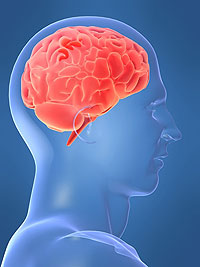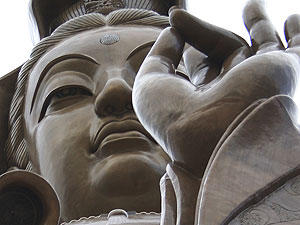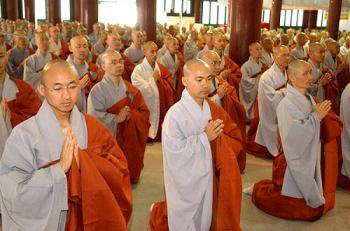Get started with mindfulness meditation — from the July 2012 Shambhala Sun magazine:
Get started with mindfulness meditation — from the July 2012 Shambhala Sun magazine: |
- Get started with mindfulness meditation — from the July 2012 Shambhala Sun magazine:
- Transforming Emotional Energy
- Thou shalt not launch IPOs, China tells temples
- There And Back Again
- The cultivation of Buddhist Ethics
- The rugby legend who became a Buddhist by reading quantum physics
- South Korea Jogye Buddhist monks launch reforms
- Why Buddhist prospered in Asia but died in India
| Get started with mindfulness meditation — from the July 2012 Shambhala Sun magazine: Posted: 11 Jun 2012 07:00 AM PDT
Basic mindfulness meditation is the foundation; get started by following these easy instructions, as found in our July 2012 magazine: Choose a quiet and uplifted place to do your meditation practice. Sit cross-legged on a meditation cushion, or if that's difficult, sit on a straight-backed chair with your feet flat on the floor, without leaning against the back of the chair. Place your hands palms down on your thighs and take an upright posture with a straight back, relaxed yet dignified. With your eyes open, let your gaze rest comfortably as you look slightly downward about six feet in front of you. Place your attention lightly on your out-breath, while remaining aware of the environment around you. Be with each breath as the air goes out through your mouth and nostrils and dissolves into the space around you. At the end of each out-breath, simply rest until the next breath goes out. For a more focused meditation, you can follow both out-breaths and in-breaths. Whenever you notice that a thought has taken your attention away from the breath, just say to yourself, "thinking," and return to following the breath. In this context, any thought, feeling, or perception that distracts you is labeled "thinking." Thoughts are not judged as good or bad. When a thought arises, just gently note it and return your attention to your breath and posture. At the end of your meditation session, bring calm, mindfulness, and openness into the rest of your day. Read More @ Source |
| Posted: 10 Jun 2012 04:00 PM PDT by Sylvia Gretchen, The Buddhist Channel, June 10, 2012Berkeley, CA (USA) -- "If we wish to explore our lives and their undiscovered possibilities, we need to be able to look steadily at our experience, no matter what it might be." Tarthang Tulku, Knowledge of Freedom.
It's not that we want to be involved in emotional turmoil. Emotions just seem to pop up. Like unwelcome guests negative emotions engage us in conversations that get in the way of what we would rather be doing, thinking, or feeling. We may not want to be anxious, but we may not seem to have much choice in the matter. The teachings of Nyingma Psychology ask us to look steadily at our inner experience so that we can discover for ourselves how emotions arise and grab our attention. There are practical and effective methods—physical postures and breathing practices—that can immediately help release the hold of negative emotions. Most of the techniques, however, form part of an on-going path of inner discovery.
Since it is not always easy to observe your mind in the midst of an upsetting situation, it can be helpful consciously to bring a negative emotion to mind when you are calm and balanced (this is best done with an instructor at first). Stir up the emotion through images or memories. Make it as real and intense as possible; feel the emotion in your body as well as in your mind. As you observe how the emotion arises and develops, note especially how your thoughts weave the story of why you are upset or angry. A single thought or image is just a momentary event—appearing and disappearing quickly. But thoughts move quickly, spinning a dense and convincing web of meaning. Continue to observe your mind, watching thoughts and images emerge, but refusing to be convinced by their compelling narrative. Watch your mind in the same way you would watch a rushing mountain stream: noticing each ripple and eddy as it forms, but not losing sight of the almost magical process of the flowing water taking momentary shape. When we view the stories of our thoughts in this way, a broader appreciation of the mind and mental events develops. We start to question the power of the 'storyteller.' We learn to look within and around thoughts and images for a more essential clarity and a deeper meaning. This is just a beginning. According to the teachings of the Buddha the positive potential of the mind is vast. Buddhist masters have studied ways to unlock this potential for over 2,500 years. They have left a remarkable body or knowledge about the human psyche. We can draw on these insights and practices to stimulate our own brilliant body of knowledge. Sylvia Gretchen is the co-dean of the Nyingma Institute. To learn more about transforming Negative Emotions: Take a class: "Transforming Negative Emotions" is offered on Mondays from 8-9:30 PM from June 11-August 13. Cost is $ 180 and the instructor is Sylvia Gretchen. Join a certificate program: A year-long program in Nyingma Psychology Program leads you through the fundamental insights and practices of this experiential approach to a healthy, happy, and spiritually fulfilling life. Read these books: "Gesture of Balance," "Hidden Mind of Freedom," and "Knowledge of Freedom" by Tarthang Tulku discuss effective ways to use meditation and analysis to release the hold of negative emotions. Available at the Nyingma Institute bookstore. Speak to an academic adviser: call (510) 809-1000 to make an appointment or email: Nyingma-Institute@Nyingma.org About Sylvia Gretchen, Co-Dean of the Nyingma Institute, has studied and worked with Tibetan Lama Tarthang Tulku since 1969. She has served as Co-Dean of the Nyingma Institute since 1996 and has also worked extensively with Tibetan sacred art and literature under the direction of Tarthang Tulku. She served for over 20 years as a research editor with Dharma Publishing, working with the Tibetan texts that have been published in the 755 Volume Great Treasures of Ancient Teachings. She is a member of the Yeshe De translation team and is a writer and editor for Dharma Publishing. Sylvia has taught Nyingma Meditation, Buddhist Studies, Nyingma Psychology and Practices, and Tibetan Art and Language at the Nyingma Institute since 1974. Read More @ SourceLaughing Buddha 3 This posting includes an audio/video/photo media file: Download Now |
| Thou shalt not launch IPOs, China tells temples Posted: 10 Jun 2012 03:00 PM PDT Reutyers, June 6, 2012SHANGHAI, China -- Buddhist and Taoist temples have no right to go public and list shares on stock exchanges, a Chinese official was quoted in state media as saying of an issue that seems to have touched a nerve with the officially atheist government.
Schemes to promote tourism via temples, or even for temples to band together and go public to raise funds, were wrong, Xinhua news agency quoted Liu Wei, an official with the State Administration of Religious Affairs, today as saying. Such plans "violate the legitimate rights of religious circles, damage the image of religion and hurt the feelings of the majority of religious people", he said in remarks at a conference on the management of religious sites.
Shanghai-listed Huangshan Tourism Development Co, for example, sells admission to Huangshan, or the Yellow Mountain, a UNESCO World Cultural and Natural Heritage site in the southern Chinese province of Anhui. And the sale of admission tickets to the famed Emei Mountain in southwest China is also an important source of income for Shenzhen-listed Emei Shan Tourism Co. China's Communist-run government is officially atheist but the state recognises Buddhist, Taoism, Islam, Catholicism and Protestantism, and tolerates religious activity within boundaries. Read More @ Source |
| Posted: 10 Jun 2012 02:00 PM PDT Where have you been?
That's what we would say as kids when asked where we had been. I have been there and back and there and back several times in the past days. All good stuff except for time spent in the rain admiring the wild flowers on the side of the M6 motorway while waiting for the rescue truck! No photos of the flowers however here's a couple of pictures for you.  Shed art spotted by blog reading companion while out on a walk today.  Champion Beagles at a petrol station. sad eyes. Beagle pack. Talking to the proud owner as I filled up with petrol I caught the sense of what they are all about. What they are bred for. That's hunting. What is it about the eyes of those hounds? Their sad eyes drew me in. Read More @ Source Namo Tassa Bhagavato Arahato Sama Sambuddhassa This posting includes an audio/video/photo media file: Download Now |
| The cultivation of Buddhist Ethics Posted: 10 Jun 2012 01:00 PM PDT by Richard Gilliver, The Buddhist Channel, June 10, 2012London, UK -- We are fortunate as Buddhists to have such a well developed ethical system in place which promotes the cultivation of such a positive and rewarding outlook and the ability to respond with such clarity and measure to difficulties that may arise both in our practice and situations that may arise in every day life.
I noticed this recently when I was thumbing through an older translation of the Anguttara Nikaya, and it struck me how someone new to the practice might, if they were reading one of these earlier texts misinterpret the meaning based on their westernised understanding of the work. Personally speaking I prefer in many instances the older copies of the canon in English but I have the advantage of having many years of study behind me relating to the texts, as such I am not prone (although admittedly, not immune) to the occasional 'blunder' when it comes to reading the works.
The Buddha was quite straightforward in the implementation of his ethical instruction. The follower of the Buddha was to develop skilful qualities and abandon those qualities that were unskilful. These qualities are to be developed in line with the backdrop of Buddhist meditation, that is, concentration with the directed analysis of thoughts as they arise and fall away. It is with this simple, yet effective mindfulness technique that one can be aware of attributes that arise that are a benefit to the path and cultivate them, while attributes that are a detriment to the path may be observed as such and avoided. The Zen teacher Thich Nhat Hanh refers to this process, quite beautifully, as watering the good seeds of the mind. In the Buddhist system those qualities indicated as skilful relate to the 'path' the Buddha set out. He told his followers not to engage with metaphysical questions which would detract from the practice. This is a very important point, and relates both to the translation difficulties I touched on earlier and the advantages of Buddhist ethics over secular ethics. The Buddhist ethical practice does not relate to 'good' and 'bad' ethical behaviour, that is, in our western society where our ethical system developed largely from Christian ethical standards which were based on innate 'good and evil' qualities. The Buddha's path did not rely on these ethical boundaries and instead related to those qualities that would aid one in attaining Nibbana (Nirvana). Thus the skilful qualities one develops on the Buddhist path don't directly relate to the 'good' qualities one would associate with normal ethical standards. If I may refer to the afore mentioned metaphysical questions to demonstrate. In the western ethical model questioning the nature of the universe would not be deemed unethical, as it doesn't infringe on our ethical 'good/bad' position. In the Buddhist model such questions would be deemed unskilful, that is they would distract one from the task at hand, that is, the attainment of Nibbana. In relation to some of the earlier translations of the texts this could prove problematic, as what has been translated in modern texts as skilful/unskilful respectively was, in older translations described as good/evil. For the casual observer, or those new to the practice this can cause great difficulty in ascertaining the context of the text, if I am conditioned to view good and evil in the western sense then reading it in a Buddhist text would automatically lead me to think the same ethical viewpoint is being propagated. Notwithstanding the early translations are valuable resources and should be treasured as such, it is prudent that one is mindful when reading them to bear in mind there age and the style of the translation. When we stand Buddhist ethics and western ethics side by side in our every day life what can we take from Buddhism that will allow us to benefit from them in day to day living? The development of skilful qualities is paramount to achieving Nibbana. As with all of the Buddha's teaching it is the subtlety that is the beauty. We develop Buddhist ethics against the backdrop of meditation, yet it is those qualities that allow us to attain deeper levels of concentration. In short, the Buddha's ethical teaching is not a see saw of balancing good against bad. It is a wheel that when set into motion becomes a self fulfilling entity, the more you practice Buddhist ethics the more concentration and insight develops, the more concentration and insight develops the clearer Buddhist ethics become, the clearer they become the subtler the level of concentration and insight. The Buddhist system of ethics is quite simple in comparison with many other systems, and yet through the Buddha's insight the wheel he set in motion can achieve such subtleties that it will eventually put an end to suffering – and that, in itself, seems to me a goal worth practicing for. --------- Thai Pali Chanting 泰国巴利经文 This posting includes an audio/video/photo media file: Download Now |
| The rugby legend who became a Buddhist by reading quantum physics Posted: 10 Jun 2012 12:00 PM PDT by Walter Jayawardhana, The Buddhist Channel, June 10, 2012Colombo, Sri Lanka -- The rugby legend Jonny Wilkinson hit world headlines due to his 2003 World Cup final heroics, when his drop goal in the last minute of extra-time delivered the trophy to England. He made another sensation when he told the London Times that he became a Buddhist by reading Quantum Physics.
The former England Rugby star, who became a national hero after the world cup victory, said Meditation had helped him overcome a fear of failure which was ruining his life ironically due to the victory.. London's Daily Mail said, "His obsessive perfectionism had been making him miserable but Meditation had liberated him from being motivated by 'money, status tars, or ego'." He said moments after he won the world title against Australia in Sydney he was having strong feelings of anti-climax.
After winning the World Cup serious injuries put him out of international rugby for four years. During this derailment he tried to learn guitar, piano ,French and Spanish as a distraction. A report said, "In the end he had a 'Eureka' moment while reading a book on quantum physics – the study of sub-atomic particles." 'Quantum physics helped me to realise that I was creating this destructive reality and that all I needed to do to change it was to change the way I chose to perceive the world,' he told the Times. 'I do not like religious labels, but there is a connection between quantum physics and Meditation, which I was also getting into. His epiphany came after reading about a famous experiment in quantum physics known as Schrodinger's Cat, a report said. "It was all about the idea that an observer can change the world just by looking at something; the idea that mind and reality are somehow interconnected," Wilkinson explained. "It is difficult to put into words, but it hit me like a steam train." He continued: "I came to understand that I had been living a life in which I barely featured. I had spent my time immersed in the fear of not achieving my goals and then spent my time beating myself up about the mistakes I made along the way. Quantum physics helped me to realise that I was creating this destructive reality and that all I needed to do to change it was to change the way I chose to perceive the world. 'Failing at something is one thing, but Meditation tells us that it is up to us how we interpret that failure. 'The so-called Middle Way is also about having the right intentions. "[Buddhism] a philosophy and way of life that resonates with me," he revealed. "I identify with it. I agree with so much of the sentiment behind it. I enjoy the liberating effect it's had on me to get back into the game." 'Are they decent and honest and are you giving consideration to other people? Selfishness can never be the route to happiness or success.' Wilkinson's live-in girlfriend Shelley Jenkins, 27, the daughter of a scaffolding magnate, is apparently 'really happy' about Wilkinson's new enlightenment. 'I have improved as a person in my relationships, not just with her, but with friends and family,' he said. Asked to explain the deeper reason for his Buddhist faith, he added: 'I think it was rooted in an even deeper fear of death. 'I couldn't figure out how to avoid death: it was like a game I could not win. The closer I got to family and friends and the better things got, the more I had to lose. 'I have accepted my career will finish one day and I am in a place that will enable me to make that transition comfortably. I will not have to reinvent myself to cope with life after rugby.' He told the French news agency AFP, "Buddhism, with its concepts of karma and rebirth, have freed me from the twin fears of death and life without rugby. It has given me the ability to understand that rugby, like life, will also come to an end." "My motivation today has nothing to do with status, money or ego. Before I wanted to be the best in the world and I would watch other players to see how I measured up. Now when I do something great on the rugby pitch it is not about being better than others but about exploring my talent ... My fulfillment is no longer about self-gratification; it is about seeing the happiness of others." Read More @ Source |
| South Korea Jogye Buddhist monks launch reforms Posted: 10 Jun 2012 11:00 AM PDT BBC, June 7, 2012Seoul, South Korea -- Buddhist leaders in South Korea have announced that they will bring in professional managers to run temple finances, following recent "misbehaviour" by several monks.
The country's main Jogye Order has been dogged by in-fighting and criticism since the latest scandal. It has sparked a fresh debate on the role of monks in modern-day Korea. The reforms mean that monks will focus on "self-discipline" and "missionary work" - not running temple affairs. Instead, financial managers will be brought in to handle the accounts, and lay people will take over the day-to-day running of temples.
Last month, several monks were caught on camera smoking, drinking and gambling in a hotel bedroom. Gambling is illegal in South Korea, apart from in designated places such as casinos catering mostly to tourists. It is also a violation of the code of conduct for monks of the Jogye Order. The video unleashed a spate of allegations against senior figures in the order - that they too had drunk alcohol, gambled and even paid for sex. The order says it has more than 10 million followers - about 20% of the population of South Korea. But it has reportedly been hit by feuds and factional in-fighting. Buddhist leaders have repeatedly said there would be strict penalties for those who tarnished the image of the country's monks. The BBC's Lucy Williamson in Seoul says that many in South Korea believe that Buddhist is already struggling to remain relevant in the face of Christianity and capitalism. Local media reports last month said that the footage was thought to have been shot by a monk from the order described as an opponent of its current administration. Read More @ SourceRam Dass - Part 1 Complete: Compassion in Action - Thinking Allowed with Jeffrey Mishlove This posting includes an audio/video/photo media file: Download Now |
| Why Buddhist prospered in Asia but died in India Posted: 10 Jun 2012 10:00 AM PDT By Shenali Waduge, Asian Tribune, June 10, 2012New Delhi, India -- Undoubtedly, the philosophy of Buddhist is one of the greatest gifts to mankind. Its peaceful concepts have distanced its followers from wars, crusades and is a binding formula for the entire South/South Eastern/Central/East Asian region of the world of which most nations are Buddhist countries whilst others including India are not.
With time the Brahminical Social Order began to secure greater advantage over Buddhist and with royal patronage shifting from Buddhist to Hinduism, the fate of Buddhist was sealed and the great philosophy all but disappeared from India with little help of revival even from State Governments. Why India chose to forget Buddhist
Needless to say for whatever reasons, Buddhist did decline and disappeared in India. Historian S. R. Goyal has attributed the decline and disappearance of Buddhist from India to the hostility of the Brahmanas. An incident oft cited is the destruction of the Bo Tree and Buddhist images by Saivite King, Shashanka, persecution by Pusyamitra Sunga (185 BC to 151 BC) who detested the Law of the Buddha had set fire to the Sutras, destroyed Stupas, razed Samgharamas and massacred Bhikkus and even killed the deity of the Bodhi tree. There is also mention of the Huna onslaught on Taxila (in Pakistan), the persecution of Buddhist monks by Mihirkula. Incidentally, though Moghuls are accused of destroying Hindu temples, most of these temples were actually built on Buddhist shrine sites. Results of Moghul invasions were many too - Somapura Mahavihara (now in Bangladesh) was set ablaze. Odantapuri Mahavihara close to Nalanda was razed to the ground in 1199 CE after killing all the monks and Bodhgaya was attacked as well. Though there is evidence that even a century beyond the Muslim conquest Buddhist remained in places like Gaya till the end of the 14th century which disproves the notion that Muslim conquest was not singularly responsible for the decline of Buddhist in India. Thus the inability to gage a particular time period for the process of decline until Buddhist collapsed towards the end of the 12th century. Yet, the question remains if Jainism survived why Buddhist didn't? The Bengal Puranas depict the Buddhists as being mocked and subject to verbal chiding. Yet persecutions may suppress but it does not kill a religion! So what really happened to Buddhist in India? No Hindu civilization before Buddhist There is no mention of "Hindu" in ancient Aryan literature nullifying the belief that a Hindu nation existed. Hindus profess to be Aryans citing the Rigveda as the oldest literature in the world. However, Rigveda was written in Sanskrit and contains references to Prakrit language (600 BCE to 1000 CE) and Prakrit was associated with Buddhist. The Rigveda also contains Vaidik prayer to God Indra to kill Dasas. Dr. Ambedkar claims Dasas and Nagas were the same people and were rulers of India when the Rigveda was written. The Rigveda also mentions Rishis like Bharadwaj, Vasistha, Bhrigu, Viswamitra etc – Buddhist literature mentions these are Buddha's contemporary so the Rigveda could not have been the oldest document in the world. There is neither archeological evidence nor literary evidence that Sanskrit is anterior to Buddhist? Hindu historian Dr. Majumdar claims that 75% of Hindu culture derives from Dravidian culture. According to Brahminical literature the Chaturvarna (Brahmins, Kshatriyas, Vaishyas and Sudras), the Kshatriyas were exterminated by Brahmin leader Parasuram. The Brahim text the Gita mentions Vaishyas, Sudras and women as belonging to papyoni – in other words they were non-Hindus. We also know that the Vaishyas and the Sudras were disallowed to hear or recite the Vedas. Moreover, the science of medicine – Ayurveda was the profession of the Sudras and Charak Samhita the father of Ayurveda was not only a Buddhist but also the physician of Buddhist emperor Kanishka. The truth remains that there is nothing like Aryan civilization and Vedic period in Indian history anterior to Buddhist. Prakrit the language of the indigenous people was associated with Buddhist in ancient times. In reality, the Buddhist language is associated with the Harappan culture as inscriptions used by Buddhist emperor Ashoka to propagate his message to the people were derived from the language of the Harappan people. Aryan is a distortion of the word Iranian. In all probability the Vaidiks falsely inserted the myth that "Aryan culture" and "Vedic period" in the historical sequence anterior to Buddhist because they did not want to disclose that the Brahminical culture came after Buddhist. It was essentially an inferiority issue. It is clear that there was no "Hindu civilization" before Buddhist, there was no "Vedic" period before Buddhist because Sanskrit developed after Buddhist and it was during the Buddhist period that the Vedas were manufactured. Not wanting to give due place to Buddhist it is often argued that the Vedas were not written and were merely passed down over generations through oral scriptures (Shruties). If so, then why were they not called Vedas instead of shruties? If Sanskrit did not exist before Buddhist in what language were the Vedas or shruties passed down from generation to generation? The Hindu era We all agree that the history of all religions began from their leaders – the Buddhist era began with Lord Buddha, the Christian era began with Jesus Christ...etc. The Hindu era begins from Vikrami Samvat (from Hindu king Chandra Gupta Vikramaditya) and Shaka Samvat which are 2055 and 1922 years old respectively. Yet, there cannot be two eras for Hindus – the Shaka era started from 78AD related to Kanishka, a Buddhist emperor of the Kushan dynasty. Hindu Brahminisation began with the Shaka era and continued to the Vikram era. The first archaeological evidence of Sanskrit (language of Hindu Brahmins) called Rudra Danam inscriptions belong to the period of the Shaka rulers (Mathura, Nasik and Ujjain their capitals). Shaka era actually started from Kanishka, a Buddhist emperor of Kushan dynasty. Instead of Shaka era it should be called Kushan era. Another question seeks to ask why Vikram era associated with Chandra Gupta 11 was made anterior to Shaka era? What is the relationship of the Hindus with the Shakas and Chandra Gupta? Kanishka was associated with Buddhist while Chandra Gupta was associated with Hindu Brahmanism. The only possible conclusion we can derive is that Vikram era was made anterior to Shaka era to make Buddhist inferior to Hinduism. It was during the Shaka era that Buddhist came to be divided into Mahayana and Hinayana. It was during the Vikram era that Pali, the language of the Buddhists was exterminated. Hindu history is perhaps just 2055 years old but in order to show its superiority it exterminated Pali and destroyed the cultural and religious identity of Buddhist. There sealed the fate of Buddhist in India. Buddhism in Asia Buddhism has strong foundations in Thailand, Burma and Sri Lanka whilst in other parts of South/South East Asia it is facing difficulties. The countries ruled by colonists resulted in persecution of Buddhist through missionary Christian/Catholic schools. Undoubtedly, there is a resurgence to revive Buddhist and to bring all Buddhist nations together. South/South East Asia Theravada Buddhist - Indonesia, Malaysia, Burma, Thailand, Bangladesh, Laos, Cambodia, Vietnam and Sri Lanka. In India it was only after Ambedkar started a neo-Buddhist movement among the untouchables in the 1950s that Buddhist came to be somewhat revived. In India it is mostly the Indian "untouchables" who are embracing Buddhist. There are 300m Dalits who to survive caste discrimination are turning to different faiths. We may recall how 50,000 Indian dalits converted to Buddhist. Out of 28 Indian states and 7 union territories Buddhist's reach has become minimal. It is in the state of Maharashtra that 74% of total Indian Buddhists reside followed by Sikkim, Arunachal Pradesh, Mizoram and Karnataka, UP, West Bengal, Madhya Pradesh. East Asian/Central Asian Mahayana Buddhist – Taiwan, Hong Kong, South Korea, Japan, Nepal and Bhutan, Ladakh, Russia and China (non-Han regions – Tibet, Inner Mongolia and Xinjian (East Turkistan). Han Chinese in inner China have also developed an interest in Buddhist. It goes without saying that for a very peaceful practicing philosophy the currents that Buddhist and Buddhists have faced over ancient times and even towards contemporary times will never find answers as to why Buddhist has faced the challenges it weathered. There is no streak of violence in Buddhist. It is only about one's own journey towards salvation along a middle path that espouses to refrain from either extremes to finding the Truth for oneself. That Truth is not the same for any of us, yet it is the Truth nevertheless. Similarly in the West too, the people have found Buddhist to be an easy philosophy to understand and follow. Thus, in the US, Europe, Australia, Canada and even South America plenty of "Dharma centers" have emerged in over 90 countries. Undoubtedly, we must mention Indo-Sri Lanka relationship and make special mention that there has never been a period of cordiality as that which existed during the time of King Asoka of India and King Devanampiyatiss of Sri Lanka. Regrettably, India has chosen to treat Sri Lanka as a quasi-enemy and has continued to carry out destabilizing operations against Sri Lanka. India's present overtures towards aligning with Sri Lanka through Buddhist shows clear signs of seeking to be a partner of the Asian block through Buddhist since India has antagonized enough of its neighbors already. While India plays no role in the future of Buddhist except its treatment along scholarly lines devoid of emotional attachment, it is the practice, the understanding, the reverence given to Buddhist that is seeing a revival and a greater binding amongst South/South East/Central/East Asian countries of the world and Sri Lanka should take a lead to create greater binding. Read More @ Source中国经典动画片- 孔子- 大学《经》(全集) This posting includes an audio/video/photo media file: Download Now |
| You are subscribed to email updates from BuddhaRocks ☸ Buddhist To stop receiving these emails, you may unsubscribe now. | Email delivery powered by Google |
| Google Inc., 20 West Kinzie, Chicago IL USA 60610 | |

 Our annual all-teachings issue
Our annual all-teachings issue From time to time we ask students in Nyingma Psychology programs at the Nyingma Institute to note the proportion of time they spend each day involved with negative emotions. Most people are amazed by the results. When they take into account boredom and dissatisfaction (along with the more obvious emotions such as anger, anxiety, and fear) the answer is usually over 50% of the time. And these are 'normal' people who are considered healthy and happy.
From time to time we ask students in Nyingma Psychology programs at the Nyingma Institute to note the proportion of time they spend each day involved with negative emotions. Most people are amazed by the results. When they take into account boredom and dissatisfaction (along with the more obvious emotions such as anger, anxiety, and fear) the answer is usually over 50% of the time. And these are 'normal' people who are considered healthy and happy. The listing of companies linked to world famous Chinese heritage sites is not new in the country's three-decade-old capital markets, but attempts to list at least one religious site have apparently crossed a line.
The listing of companies linked to world famous Chinese heritage sites is not new in the country's three-decade-old capital markets, but attempts to list at least one religious site have apparently crossed a line. I would like to touch upon what I believe are the advantages of the Buddhist ethical standard over secular viewpoints but first I want to make a brief comment about translation relating to our ethical guidelines.
I would like to touch upon what I believe are the advantages of the Buddhist ethical standard over secular viewpoints but first I want to make a brief comment about translation relating to our ethical guidelines. Wilkinson, a millionaire by then has revealed that he has found inner peace through Meditation.
Wilkinson, a millionaire by then has revealed that he has found inner peace through Meditation. << Jogye Order is the representative order of traditional Korean Buddhist with roots that go all the way back 1,200 years
<< Jogye Order is the representative order of traditional Korean Buddhist with roots that go all the way back 1,200 years The Buddha was not interested in numbers nor was he interested in the lay deity having a distinct identity. There were no social codes, modes of worship…in other words adherence to the Buddhist faith was not obligatory unlike other religions of the world. Anyone, irrespective of caste, creed was welcome to take refuge in the teachings of Buddha, Dhamma and Sangha. There was no exclusive allegiance nor was lay deity required to perform regular religious service – essentially everything was voluntary. Only those that understood the philosophy behind Buddhist would be able to cherish its value.
The Buddha was not interested in numbers nor was he interested in the lay deity having a distinct identity. There were no social codes, modes of worship…in other words adherence to the Buddhist faith was not obligatory unlike other religions of the world. Anyone, irrespective of caste, creed was welcome to take refuge in the teachings of Buddha, Dhamma and Sangha. There was no exclusive allegiance nor was lay deity required to perform regular religious service – essentially everything was voluntary. Only those that understood the philosophy behind Buddhist would be able to cherish its value.